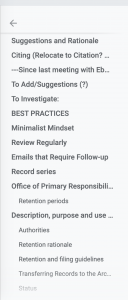LibAsk is an email researchers and library patrons contact with a wide range of questions from update on COVID-19 procedures to complex research questions.
Retention Records Management and organizing a shared depository of research questions was a new and seemingly daunting task in the beginning, but fortunately SFU has a collection of RRSDAs that I was able to refer to and use to guide my own work.
In addition to the RRSDA, I created best practices for tasks such as deleting old messages and organizing LibAsk email folders more effectively.
Below is a snapshot summary of some of the components of this project (full components not shared for privacy reasons).

I'm satisfied with the best practices I identified for this project, which I feel I can apply to any shared work emails or email repositories:
BEST PRACTICES
Folder Names
When naming folders, make sure they are neutral names to reduce anxiety (avoid action words, such as ‘to-do’). Capitalize first letters on folder names for consistency.
Minimalist Mindset
Try not to create a new folder if you can help it. Rationalize the best possible folder for the email you’re dealing with.
Review Regularly
Have a regular review and reassessment of folder items. No system is perfect and more eyes are better than less in double checking that emails are filed properly.
Emails that Require Follow-up
Keep these emails in the inbox and make a note for the next librarian/colleague
As one of the co-op librarians that manage the LibAsk email, I enjoyed this project and getting feedback from others that use the system.
